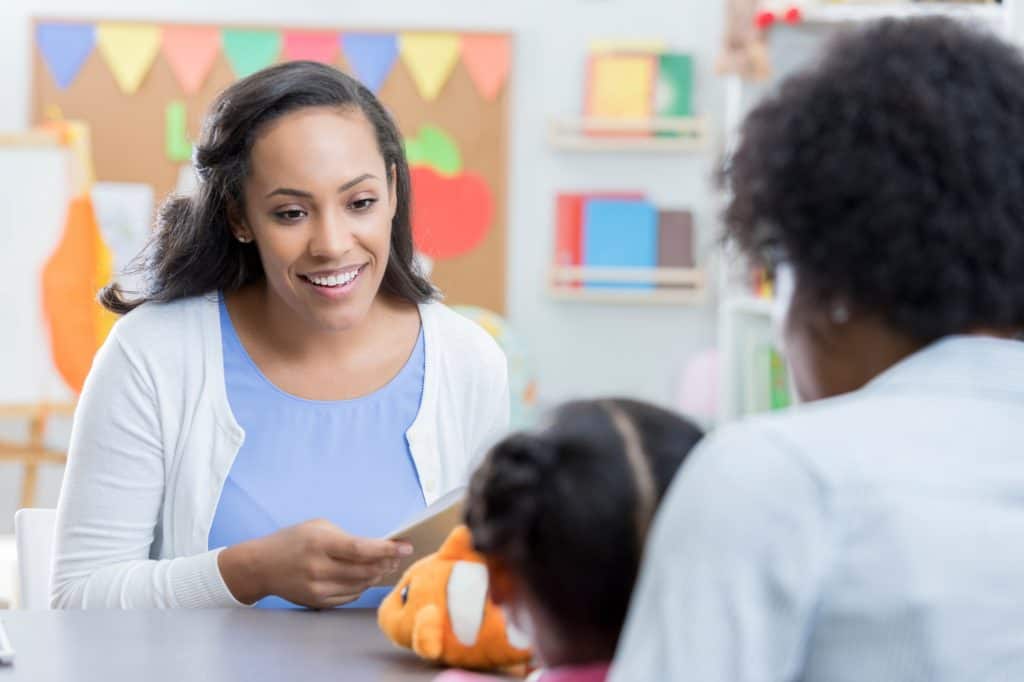Congratulations on making it to the finish line of another school year! The last few days of school can be stressful. From standardized tests to graduation ceremonies, it can feel like there’s not enough time in your school’s schedule for everything you need to get done. But if you haven’t made time for self-reflection yet, you’re missing a great opportunity. The end of the year is the ideal time to do so—for both you and your students.
Reflection is one of the most useful tools in a teacher’s wheelhouse, especially at the end of the year. It can encourage both educators and students to recognize their successes over the past year, particularly those wins that sometimes go unnoticed. Plus, if you’re looking for ways to improve as an educator, using reflection now can give you self-improvement ideas to try over summer break.
We know that it can be tough to fit another activity into a teacher’s busy schedule, but self-reflection can help with goal-setting, strengthen school atmospheres, and prevent teacher burnout. Read on to discover how to use reflection as a self-improvement strategy for teachers and students.
Professional Development for Teachers: End-of-Year Reflection
 If you’re a teacher looking for professional development ideas, self-reflection is one of the most beneficial end-of-school-year activities you can do. The end of the year is the best time for teachers to make an improvement plan for the upcoming year. If you set goals before summer break begins, you’ll be more familiar with classroom dynamics and have a better sense of how you’d like to improve.[1]
If you’re a teacher looking for professional development ideas, self-reflection is one of the most beneficial end-of-school-year activities you can do. The end of the year is the best time for teachers to make an improvement plan for the upcoming year. If you set goals before summer break begins, you’ll be more familiar with classroom dynamics and have a better sense of how you’d like to improve.[1]
End-of-year reflection can also help combat teacher burnout, which is a serious issue in education.[2] Evaluating what you’ve achieved this year and how you can still improve can help you keep from becoming complacent or even bored with your career.[3] New teachers in particular are most susceptible to burnout because they’re less experienced than their colleagues. Self-reflection can teach younger educators how to identify their strengths and weaknesses and prevent them from burning out.[4]
When teachers use self-reflection to learn and grow, it can transform their school’s entire climate for the better. When schools foster self-inquiry in their educators, teachers are more equipped to improve their classrooms and better meet their students’ needs.[5] Teachers sometimes think they don’t have the time for “self-centered” activities at the end of the year. But by making space for personal reflection, you can have the power to make your school the best it can be.
How to Use End-of-Year Reflection as a Teacher Evaluation
Self-reflection is one of the most effective methods of professional development in education because it promotes self-efficacy, or the belief that you can change or grow, as a teacher.[6] One of the most popular methods of reflection is through writing. If you have a journal or even a spare sheet of paper, you can free write about how you feel the school year went and what your plans are for self-improvement.
Here are a few examples of prompts to help you reflect on and evaluate your yearly goals:
- Which lessons were most effective with your students, and which were least effective?[7]
- What were some class challenges this year and how did you handle them?[8]
- How would you describe your relationship with students, parents, and colleagues this year?[9]
- What do you want to change for next year? How do you want to change it?
- What are your teacher goals for the next school year?
 Writing letters can be another way to process and celebrate your classroom achievements over the year. Depending on the depth of your reflection, you can write an end-of-year letter to parents or students—or, if you have the time, do both! If the end of the year is too busy or you have many students, you could also write them brief notes on index cards instead.[10]
Writing letters can be another way to process and celebrate your classroom achievements over the year. Depending on the depth of your reflection, you can write an end-of-year letter to parents or students—or, if you have the time, do both! If the end of the year is too busy or you have many students, you could also write them brief notes on index cards instead.[10]
If you want to mix self-reflection with evaluation from others, you can have a discussion with other teachers in your school.[11] Together, you could talk about what you feel like you’ve done right this year and how you’d like to improve next year. You could also ask for advice on how to tackle certain issues or what they perceive as your strengths and weaknesses. This can be especially useful for new teachers, who can gain insight from their more experienced colleagues on how to improve.
Once you’ve conducted a self-evaluation activity, take some time to plan a few goals for the next year. That way, you can put your thoughts into action and use the summer to prepare for the next year. If possible, try to write your goals out as thoroughly and specifically as possible. Research suggests that written goals are more likely to be fulfilled than goals kept in your head.[12]
End-of-School-Year Reflection Activities for Students
Teachers aren’t the only people who can benefit from end-of-year reflection: students can, too. One way to encourage reflection and goal setting for students is journaling. Instructing a student to write out their thoughts and emotions can help them solidify what they’ve learned over the year. Plus, it can be a great way for early elementary students to practice reading and writing!
These are just a few of the prompts you can use for your students at the end of the year:
- If you could pick just one thing, what was your favorite school experience this year?
- What are you most proud of accomplishing this year? [13]
- What are your strengths and weaknesses as a student?
- What was the hardest thing you did this year, and how did you overcome it? [14]
- How would you like to improve next year? [15]
Another way to get kids thinking about what they’ve learned is by having them write an end-of-year letter to the students entering your class next year.[16] Encourage them to give advice to the incoming students and share a few of the favorite things they learned this year. Not only will this promote your students to think deeply about the past year, but you’ll be able to give your new class helpful advice next year.
Sometimes it can be hard to determine how to most effectively reach students. If you’d like older elementary students to help you with your own self-reflection, you can also hand out a teacher evaluation worksheet.[17] Through conducting a teacher evaluation by students, you can get a glimpse of what you’re doing right and where you might need to improve for next year. Keep in mind, though, to always take student evaluations with a grain of salt.
Five More End-of-Year Activities for Your Classroom
Reflection activities are a great way for teachers and students to end the school year right and plan for self-improvement over summer break. But it doesn’t have to stop there: you can use a variety of activities on the last day of school to celebrate a job well done and say goodbye to your students.
Use these five end-of-school-year activities for elementary school students to thank them for all you were able to accomplish together in class:
- Yearbook Signing Party: Give your students one or two hours to write messages in each other’s yearbooks and wish their classmates a happy summer vacation! If your school doesn’t offer yearbooks, you can give each student a card for their classmates to sign instead.
- Field Trip Day: Taking a field trip to a zoo, museum, or other educational place can be a fun way to treat your students after a year of hard work.[18] You can even choose a field trip that connects to something you taught your class over the past year.
- Take a Class Photo: A group picture can give students a tangible reminder of the memories they made through the school year. Take a picture together during class, then email the file to their parents afterward so everyone has a copy.
- Student Gift Exchange: Saying goodbye to classmates can be tough, but a class gift exchange can make it a little easier.[19] You can assign each student a classmate to get an inexpensive gift for or hand out an end-of-year gift for all students in your class.
- Classroom Talent Show: Putting together a talent show can be a fun way to showcase what your students have learned (in class or in their extracurriculars) during the year. You can hold the talent show during class or, if you want to invite parents, after school.
Sources:
Cicchinelli, L.F. The Value of Teacher Evaluation. Speaking Out, September/October 2013, pp. 52-53.[1,2]
Concordia University Portland College of Education. Students Evaluating Teachers: What Educators Need to Know. Retrieved from cu-portland.edu: https://education.cu-portland.edu/blog/classroom-resources/students-evaluating-teachers-what-educators-need-to-know/.[3,17]
Cox, J. 5 End-of-the-School-Year Activities to Finish Strong. Retrieved from wgu.edu: https://www.wgu.edu/heyteach/article/5-end-school-year-activities-finish-strong1705.html.[4,10,16,18,19]
Trauma and Learning Policy Initiative. End of School Year Reflection. Retrieved from traumasensitiveschools.org: https://traumasensitiveschools.org/end-of-school-year-reflection/.[5]
Henson, R.K. Teacher Self-Efficacy: Substantive Implications and Measurement Dilemmas. Retrieved from eric.gov: https://files.eric.ed.gov/fulltext/ED452208.pdf. [6,8,11]
Konen, J. 5 Questions to Tackle When Reflecting on Teaching. Retrieved from teacher.org: https://www.teacher.org/daily/reflecting-teaching/.[7,9]
University of Cincinnati Learning Assistance Center. Setting Goals for Yourself, and Motivating Yourself to Succeed. Retrieved from ferris.edu: https://www.ferris.edu/HTMLS/colleges/university/eccc/pdf/settinggoals.pdf.[12]
Northern Illinois University Faculty Development and Instructional Design Center. Reflective Journals and Learning Logs. Retrieved from niu.edu: https://www.niu.edu/facdev/_pdf/guide/assessment/reflective_journals%20and_learning_logs.pdf.[13]
Sloan, D. Reflection Activities: Tried and True Teaching Methods to Enhance Students’ Service-Learning Experience. Retrieved from usf.edu: https://www.usf.edu/engagement/documents/s-l-reflection-activities.pdf.[14,15]

